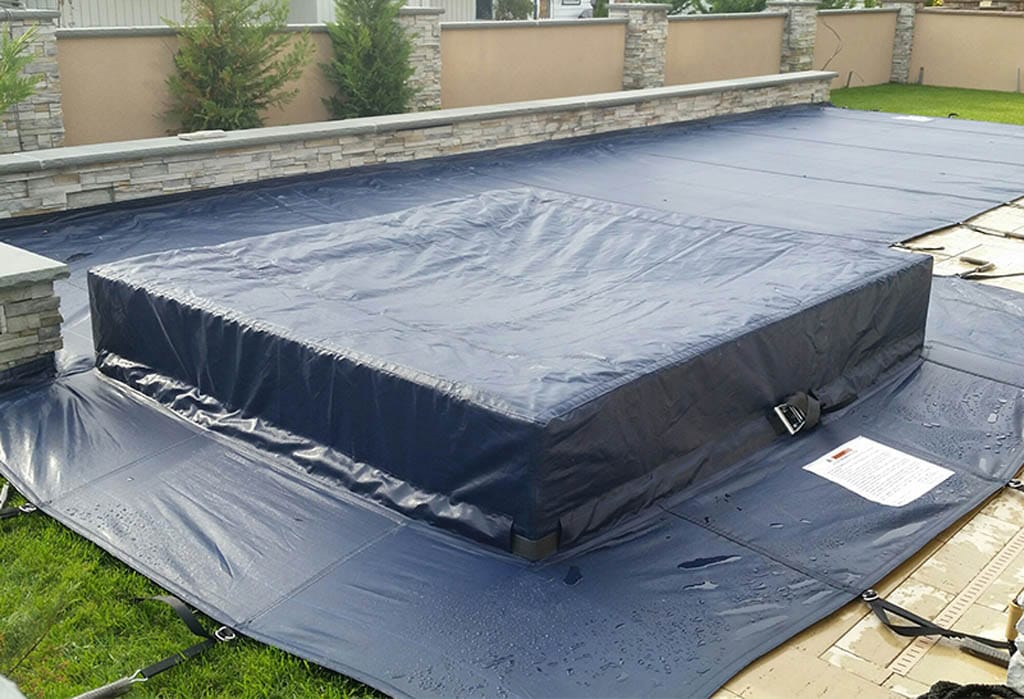Winter is just a few short months away, and that means it’s time to think about some much-needed outdoor maintenance.
Your swimming pool is a central feature during the warmer months. However, during the winter, you’ll need to take some steps to protect it. A swimming pool safety cover is a must-have, but there’s a little more involved to keep your pool safe and protected for spring next year.
Here are all the pool winterization steps that will protect your investment from damage.
Get Your Pool Chemistry Sorted
An unbalanced pH over the winter could cause deposits along your pool wall, leading to etching that will become a permanent feature.
The easiest way to balance your chemistry is with the help of a swimming pool winterization treatment. You can perform the treatment before you install your inground pool cover for the winter. Winterization chemical kits are widely available through pool dealerships and e-commerce sites.
Take Precautions to Protect Your Filtration System
 Freezing during the coldest days of the winter will expand the water in your pool. This expansion can cause extensive damage to your filter and plumbing system.
Freezing during the coldest days of the winter will expand the water in your pool. This expansion can cause extensive damage to your filter and plumbing system.
You can combat the effects of freezing by lowering your pool water below the mouth of your skimmer. Alternatively, you can use a skimmer cover door to keep water out. This will allow you to avoid partially draining your pool at the end of the year.
Clear Out Your Plumbing
Freezing could cause extensive damage to your plumbing lines over the winter. Even the best swimming pool safety covers won’t be able to prevent this.
Use a shop vac or air compressor to blow out the water from all plumbing lines, and then seal the lines at the pool end. If your pool was installed within the last ten years, your fittings will likely have threaded ends. The installer (in most cases) would have left you a set of threaded and sealed plugs for winterization.
If you didn’t receive the plugs or if you have misplaced them, you can buy replacements from a local pool supplier. If you don’t have threaded plumbing fittings, you can use a rubber freeze plug to create a seal after blowing your lines out.
Drain Your Pool Filter and Other Equipment
 Modern pool filters come with a winterization mode to prevent freezing damage. Remove the bottom plug from your filter to release the water inside. You may also be able to open an air-relief valve at the top of your filter to help the draining process.
Modern pool filters come with a winterization mode to prevent freezing damage. Remove the bottom plug from your filter to release the water inside. You may also be able to open an air-relief valve at the top of your filter to help the draining process.
Set your filter valve to the winterize setting and run the filter for a second (yes, quite literally a second of operation). This quick burst of activity will clear out any residual water from the internals. Avoid leaving the filter operational for any more than a couple of seconds during this process. Running the unit without water flow can cause extensive damage.
Drain all other equipment including your chemical feeder, automatic pump, heater, and pressure gauge. Store your pressure gauge indoors or in your garden or pool shed to prevent freezing of any water that’s left inside.
Use a Swimming Pool Safety Cover Throughout the Winter
With all these steps complete, you’ll be ready to install your inground pool cover for the winter.
You can use either a mesh or solid pool cover. Many owners in colder regions prefer to use a solid cover to prevent any water entry from rain or melting snow/ice. Both mesh and solid covers are available when you buy from Anchor Industries; America’s leading pool cover, tent, and shade manufacturer.
Winterizing your pool will keep it safe from damage, while also preventing accidental entry over the winter months. Only the best inground pool covers will provide complete winter protection for years to come. Explore your options at Anchor Industries today.